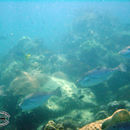Comprehensive Description
provided by Smithsonian Contributions to Zoology
Aluterus monoceros (Linnaeus)
A 1α (Figure 108) is a single section, the more dorsal part of the insertion extending into the tissues of the lips. The origin has expanded enormously to include not only the anteroventral prefrontal, but the entire infraorbital ligament as well. A 1β′ is long and thin (Figure 109), while A 1β and A 1γ are more like the generalized condition. A 2α (Figure 108) is much reduced dorsally, there being no fibers from the infraorbital ligament. A 3 is small. The adductor arcus palatini (Figure 110: A.A.P.) is divided into two sections by the junction between the metapterygoid and the parasphenoid. The retractor arcus palatini is not subdivided at all.
Most of the posteroventral fibers of the protractor hyoidei arise from the fascia over the anteroventral tip of the cleithrum. These fibers are almost at right angles to the ones originating from the posteroventral face of the anterohyal.
Rectus ventralis II (Figure 111: RECT.V.) is well developed. There is a lateral section to hypobranchial 1, an anterior section to the dorsolateral urohyal, and a transverse section across the midline. The anterior tendon of the sternobranchialis inserts on hypobranchial 2 between the two latter sections. The arrangements of the two bundles of fibers forming transversus ventralis IV are as for P. melanocephalus, but the relative positions of the bundles is reversed in transversus V. The pharyngoclavicularis externus is bifid, with tendons to ceratobranchials 4 and 5.
The anterior extension of the prootic shelf has carried the origins of the levatores externi with it (Figure 112: L.EXT.). There is some variation in the mode of insertion in levators II and IV. They may insert by a continuous aponeurosis on epibranchials 3 and 4, or separately. If the latter is the case, the anterior tendon may send a small branch to epibranchial 4. The aponeurosis of levator II sends a small section to epibranchial 3. The levatores interni retain their origin from the prootic beneath the hyomandibular foramen. Some fibers of transversus dorsalis III overlap onto the dorsal face of epibranchial 4. Obliquus dorsalis III is somewhat modified. Fibers from infrapharyngobranchial 2 pass to three different points of attachment. The medial fibers pass posteriorly to the dorsal face of infrapharyngobranchial 3. The more lateral fibers attach to epibranchial 3 (as in P. melanocephalus), while some of the ventromedial fibers loop around epibranchial 2 and reattach to infrapharyngobranchial 2.
The adductor superficialis is well developed (Figure 113: ADD.S.). The supracarinalis medius is present as a pair of cylindrical muscles, rather than the more usual triangular muscle. The erectores and depressores dorsales do not reach the vertebral column ventrally. The infracarinalis medius forms a broad tendon posterodorsally before grading into the fascia beneath the postcleithrum. Both the transversus caudalis and the spinalis are small, the latter muscle arising from the posterodorsal face of the first vertebra. In view of the fact that A. monoceros exhibits certain characters not found in any of the other monacanthids examined (particularly in the form of the adductor mandibulae complex), two additional species of the genus were dissected.
- bibliographic citation
- Winterbottom, Richard. 1974. "The familial phylogeny of the Tetraodontiformes (Acanthopterygii: Pisces) as evidenced by their comparative myology." Smithsonian Contributions to Zoology. 1-201. https://doi.org/10.5479/si.00810282.155

